Achieving Sustainable Land Use Allocation in High-Altitude Area by 2030: Insights from Circle Structure and Scenario Predictions for Production–Living–Ecological Land in Xining Marginal Area, China
Abstract
:1. Introduction
2. Materials and Methods
2.1. Study Area
2.2. Data Sources
2.3. Patch-Generating Land Use Simulation (PLUS) Model
2.4. Construction of Pythagorean Fuzzy Conflict Information (PFCI) Model
3. Scenario Prediction on PLE Land in Xining Marginal Area
3.1. Scenario Prediction on PLE Land
3.2. Scenario Prediction on PLE Sub-Land
3.3. Overall Pattern of Scenario Prediction on PLE Land in Each County
3.4. Core–Edge Mode on PLE Land in Xining Marginal Area
4. Spatial Optimization Strategies of PLE Land in Xining Marginal Area
4.1. Competitive Advantage Sets of PLE Land Under Each Scenario
4.2. Competitive Advantage Sets between Counties
- (1)
- Strong competitive advantage set: grassland ecological land (b6)
- (2)
- Weak competitive advantage set: agricultural production land (b1)
- (3)
- Potential competitive advantage set: urban living land (b3)
4.3. Spatial Distribution Optimization Strategies on PLE Land
5. Discussion and Conclusions
5.1. Discussion
5.2. Nexus Approach for the Sustainable Development in Xining Marginal Area
- (1)
- Low-speed development and high-quality urbanization
- (2)
- Mountain forest conservation
- (3)
- Plateau characteristic agriculture
- (4)
- Water tower protection
- (5)
- Live in town, pasture/farming in country
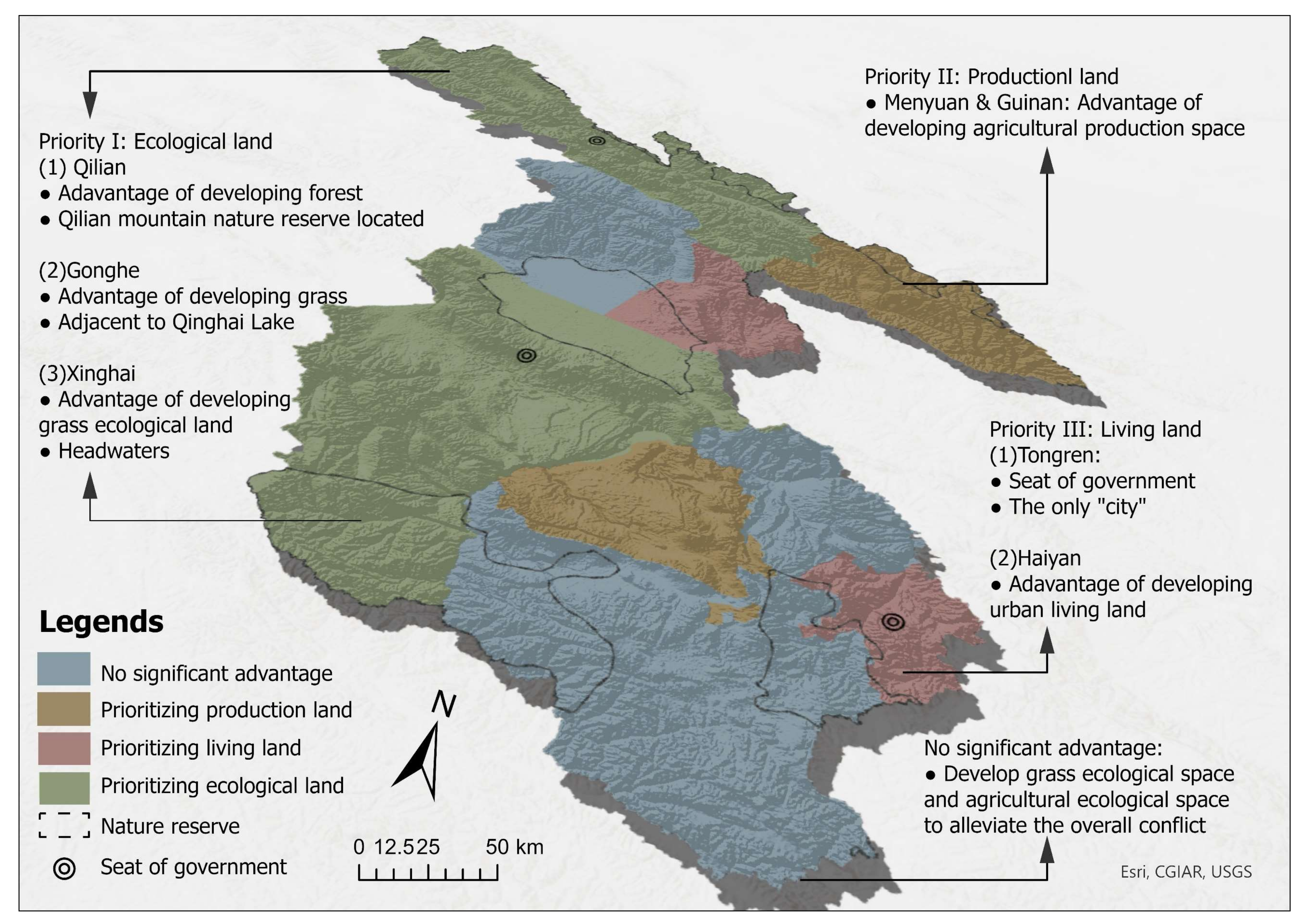
5.3. Limitations
5.4. Conclusions
Author Contributions
Funding
Data Availability Statement
Conflicts of Interest
References
- Hurtt, G.C.; Chini, L.P.; Frolking, S.; Betts, R.A.; Feddema, J.; Fischer, G.; Fisk, J.P.; Hibbard, K.; Houghton, R.A.; Janetos, A.; et al. Harmonization of land-use scenarios for the period 1500–2100: 600 years of global gridded annual land-use transitions, wood harvest, and resulting secondary lands. Clim. Chang. 2011, 109, 117–161. [Google Scholar] [CrossRef]
- Haliscelik, E.; Soytas, M.A. Sustainable development from millennium 2015 to Sustainable Development Goals 2030. Sustain. Dev. 2019, 27, 545–572. [Google Scholar] [CrossRef]
- Caiado, R.G.G.; Filho, W.L.; Quelhas, O.L.G.; Nascimento, D.L.d.M.; Ávila, L.V. A literature-based review on potentials and constraints in the implementation of the sustainable development goals. J. Clean. Prod. 2018, 198, 1276–1288. [Google Scholar] [CrossRef]
- Lu, X.H.; Zhang, Y.W.; Lin, C.R.; Wu, F. Analysis and comprehensive evaluation of sustainable land use in China: Based on sustainable development goals framework. J. Clean. Prod. 2021, 310, 127205. [Google Scholar] [CrossRef]
- Acheampong, M.; Yu, Q.Y.; Enomah, L.D.; Anchang, J.; Eduful, M. Land use/cover change in Ghana’s oil city: Assessing the impact of neoliberal economic policies and implications for sustainable development goal number one—A remote sensing and GIS approach. Land Use Policy 2018, 73, 373–384. [Google Scholar] [CrossRef]
- Sun, H.L.; Zheng, D.; Yao, T.D.; Zhang, Y.L. Protection and Construction of the National Ecological Security Shelter Zone on Tibetan Plateau. Acta Geogr. Sin. 2012, 67, 3–12. [Google Scholar]
- Han, W.; Cai, J.M.; Zhao, Y.F. Structure, mechanism, and paths of spatial governance in metropolitan fringe with the participation of multi-subjects. Prog. Geogr. 2021, 40, 1730–1745. [Google Scholar] [CrossRef]
- Liao, G.; He, P.; Gao, X.; Lin, Z.; Huang, C.; Zhou, W.; Deng, O.; Xu, C.; Deng, L. Land use optimization of rural production–living–ecological land at different scales based on the BP–ANN and CLUE–S models. Ecol. Indic. 2022, 137, 108710. [Google Scholar] [CrossRef]
- Cui, J.X.; Gu, J.; Sun, J.W.; Luo, J. The spatial pattern and evolution characteristics of the production, living and ecological space in Hubei provence. Chin. Land Sci. 2018, 32, 67–73. [Google Scholar]
- Gao, L.A.; Tao, F.; Liu, R.; Wang, Z.L.; Leng, H.J.; Zhou, T. Multi-scenario simulation and ecological risk analysis of land use based on the PLUS model: A case study of Nanjing. Sustain. Cities Soc. 2022, 85, 104055. [Google Scholar] [CrossRef]
- Reidsma, P.; Konig, H.J.; Feng, S.Y.; Bezlepkina, I.; Nesheim, I.; Bonin, M.; Sghaier, M.; Purushothaman, S.; Sieber, S.; Van, I.; et al. Methods and tools for integrated assessment of land use policies on sustainable development in developing countries. Land Use Policy 2011, 28, 604–617. [Google Scholar] [CrossRef]
- Drechsler, M.; Surun, C. Land-use and species tipping points in a coupled ecological-economic model. Ecol. Complex. 2018, 36, 86–91. [Google Scholar] [CrossRef]
- Hasegawa, T.; Fujimori, S.; Ito, A.; Takahashi, K.; Masui, T. Global land-use allocation model linked to an integrated assessment model. Sci. Total Environ. 2017, 580, 787–796. [Google Scholar] [CrossRef] [PubMed]
- Verburg, P.H.; Tabeau, A.; Hatna, E. Assessing spatial uncertainties of land allocation using a scenario approach and sensitivity analysis: A study for land use in Europe. J. Environ. Manag. 2013, 127, 132–144. [Google Scholar] [CrossRef] [PubMed]
- Chakir, R.; Le Gallo, J. Predicting land use allocation in France: A spatial panel data analysis. Ecol. Econ. 2013, 92, 114–125. [Google Scholar] [CrossRef]
- Peltonen-Sainio, P.; Jauhiainen, L.; Laurila, H.; Sorvali, J.; Honkavaara, E.; Wittke, S.; Karjalainen, M.; Puttonen, E. Land use optimization tool for sustainable intensification of high-latitude agricultural systems. Land Use Policy 2019, 88, 104104. [Google Scholar] [CrossRef]
- Sadeghi, S.H.R.; Jalili, K.; Nikkami, D. Land use optimization in watershed scale. Land Use Policy 2009, 26, 186–193. [Google Scholar] [CrossRef]
- Arciniegas, G.; Janssen, R.; Omtzigt, N. Map-based multicriteria analysis to support interactive land use allocation. Int. J. Geogr. Inf. Sci. 2011, 25, 1931–1947. [Google Scholar] [CrossRef]
- Kaim, A.; Cord, A.F.; Volk, M. A review of multi-criteria optimization techniques for agricultural land use allocation. Environ. Model. Softw. 2018, 105, 79–93. [Google Scholar] [CrossRef]
- Rahman, M.M.; Szabo, G.A. Geospatial Approach to Measure Social Benefits in Urban Land Use Optimization Problem. Land 2021, 10, 1398. [Google Scholar] [CrossRef]
- Zhao, X.; Tang, F.; Zhang, P.T.; Hu, B.Y.; Xu, L. Dynamic simulation and characteristic analysis of County production-living-ecological spatial conflicts based on CLUE-S model. Acta Ecol. Sin. 2019, 39, 5897–5908. [Google Scholar]
- Gharaibeh, A.A.; Ali, M.H.; Abo-Hammour, Z.S.; Al Saaideh, M. Improving Genetic Algorithms for Optimal Land-Use Allocation. J. Urban Plan. Dev. 2021, 147, 04021049. [Google Scholar] [CrossRef]
- Berger, T.; Schreinemachers, P. Creating agents and landscapes for multiagent systems from random samples. Ecol. Soc. 2006, 11, 19. [Google Scholar] [CrossRef]
- Liang, X.; Guan, Q.F.; Clarke, K.C.; Liu, S.; Wang, B.Y.; Yao, Y. Understanding the drivers of sustainable land expansion using a patch-generating land use simulation (PLUS) model: A case study in Wuhan, China. Comput. Environ. Urban Syst. 2021, 85, 101569. [Google Scholar] [CrossRef]
- Liu, X.P.; Liang, X.; Li, X.; Xu, X.C.; Ou, J.P.; Chen, Y.M.; Li, S.; Wang, S.; Pei, F. A future land use simulation model (FLUS) for simulating multiple land use scenarios by coupling human and natural effects. Landsc. Urban Plan. 2017, 168, 94–116. [Google Scholar] [CrossRef]
- Liu, J.G.; Hull, V.; Godfray, H.C.J.; Tilman, D.; Gleick, P.; Hoff, H.; Pahl-Wostl, C.; Xu, Z.; Chung, M.G.; Sun, J.; et al. Nexus approaches to global sustainable development. Nat. Sustain. 2018, 1, 466–476. [Google Scholar] [CrossRef]
- Flammini, A.; Puri, M.; Pluschke, L.; Dubois, O. Walking the nexus talk: Assessing the water-energy-food nexus in the context of the sustainable energy for all initiative. J. Phys. Chem. A 2014, 115, 7869–7870. [Google Scholar]
- Rasul, G. Food, water, and energy security in South Asia: A nexus perspective from the Hindu Kush Himalayan region. Environ. Sci. Policy 2014, 39, 35–48. [Google Scholar] [CrossRef]
- Shi, M.J.; Wu, H.Q.; Jiang, P.A.; Zheng, K.; Liu, Z.; Dong, T.; He, P.; Fan, X. Food-water-land-ecosystem nexus in typical Chinese dryland under different future scenarios. Sci. Total Environ. 2023, 880, 163183. [Google Scholar] [CrossRef]
- He, X.H. Analysis on Land Use Structure of Ecological-production-living land in Shaanxi Province. Remote Sens. Inf. 2021, 36, 120–124. [Google Scholar]
- Li, G.D.; Fang, C.L. Quantitative function identification and analysis of urban ecological-production-living lands. Acta Geogr. Sin. 2016, 71, 49–65. [Google Scholar]
- Liu, J.L.; Liu, Y.S.; Li, Y.R. Classification evaluation and spatial-temporal analysis of “production-living-ecological” lands in China. Acta Geogr. Sin. 2017, 72, 1290–1304. [Google Scholar]
- Zhang, H.Q.; Xu, E.Q.; Zhu, H.Y. An ecological-living-industrial land classification system and its spatial distribution in China. Resour. Sci. 2015, 37, 1332–1338. [Google Scholar]
- Wang, J.N.; Zhang, Z. Land Use Change and Simulation Analysis in the Northern Margin of the Qaidam Basin Based on Markov-PLUS Model. J. Northwest For. Univ. 2022, 37, 139–148. [Google Scholar]
- Wang, B.S.; Liao, J.F.; Zhu, W.; Qiu, Q.Y.; Wang, L.; Tang, L. The weight of neighborhood setting of the FLUS model based on a historical scenario: A case study of land use simulation of urban agglomeration of the Golden Triangle of Southern Fujian in 2030. Acta Ecol. Sin. 2019, 39, 4284–4298. [Google Scholar]
- Zadeh, L.A. Fuzzy sets. Inf. Control. 1965, 8, 338–353. [Google Scholar] [CrossRef]
- Yager, R.R. Pythagorean Membership Grades in Multicriteria Decision Making. IEEE Trans. Fuzzy Syst. 2014, 22, 958–965. [Google Scholar] [CrossRef]
- Fang, C.L. Special thinking and green development path of urbanization in Qinghai-Tibet Plateau. Acta Geogr. Sin. 2022, 77, 1907–1919. [Google Scholar]
- Giuliani, G.; Mazzetti, P.; Santoro, M.; Nativi, S.; Van Bemmelen, J.; Colangeli, G.; Lehmann, A. Knowledge generation using satellite earth observations to support sustainable development goals (SDG): A use case on Land degradation. Int. J. Appl. Earth Obs. Geoinf. 2020, 88, 102068. [Google Scholar] [CrossRef]
- Liu, Y.S.; Zhang, Z.W.; Wang, J.Y. Regional differentiation and comprehensive regionalization scheme of modern agriculture in China. Acta Geogr. Sin. 2018, 73, 203–218. [Google Scholar]
- Li, H.X.; Liu, G.H.; Fo, B.J. Response of vegetation to climate change and human activity based on NDVI in the Three-River Headwaters region. Acta Ecol. Sin. 2011, 31, 5495–5504. [Google Scholar]
- Zhou, K.; Liu, H.C.; Fan, J.; Yu, H. Environmental stress intensity of human activities and its spatial effects in the Qinghai-Tibet Plateau national park cluster: A case study in Sanjiangyuan region. Acta Ecol. Sin. 2021, 41, 268–279. [Google Scholar]
- Zhou, L.; Dang, X.W.; Sun, Q.K.; Wang, S.H. Multi-scenario simulation of urban land change in Shanghai by random forest and CA-Markov model. Sustain. Cities Soc. 2020, 55, 102045. [Google Scholar] [CrossRef]
- Bao, W.K.; Yang, Y.Y.; Zou, L.L. How to reconcile land use conflicts in mega urban agglomeration? A scenario-based study in the Beijing-Tianjin-Hebei region, China. J. Environ. Manag. 2021, 296, 113168. [Google Scholar] [CrossRef] [PubMed]
- Jiang, S.; Meng, J.J.; Zhu, L.K.; Cheng, H.R. Spatial-temporal pattern of land use conflict in China and its multilevel driving mechanisms. Sci. Total Environ. 2021, 801, 149697. [Google Scholar] [CrossRef] [PubMed]
- Zou, L.L.; Liu, Y.S.; Wang, J.Y.; Yang, Y.Y. An analysis of land use conflict potentials based on ecological-production-living function in the southeast coastal area of China. Ecol. Indic. 2021, 122, 107297. [Google Scholar] [CrossRef]
- Jiang, S.; Meng, J.J.; Zhu, L.K. Spatial and temporal analyses of potential land use conflict under the constraints of water resources in the middle reaches of the Heihe River. Land Use Policy 2020, 97, 104773. [Google Scholar] [CrossRef]

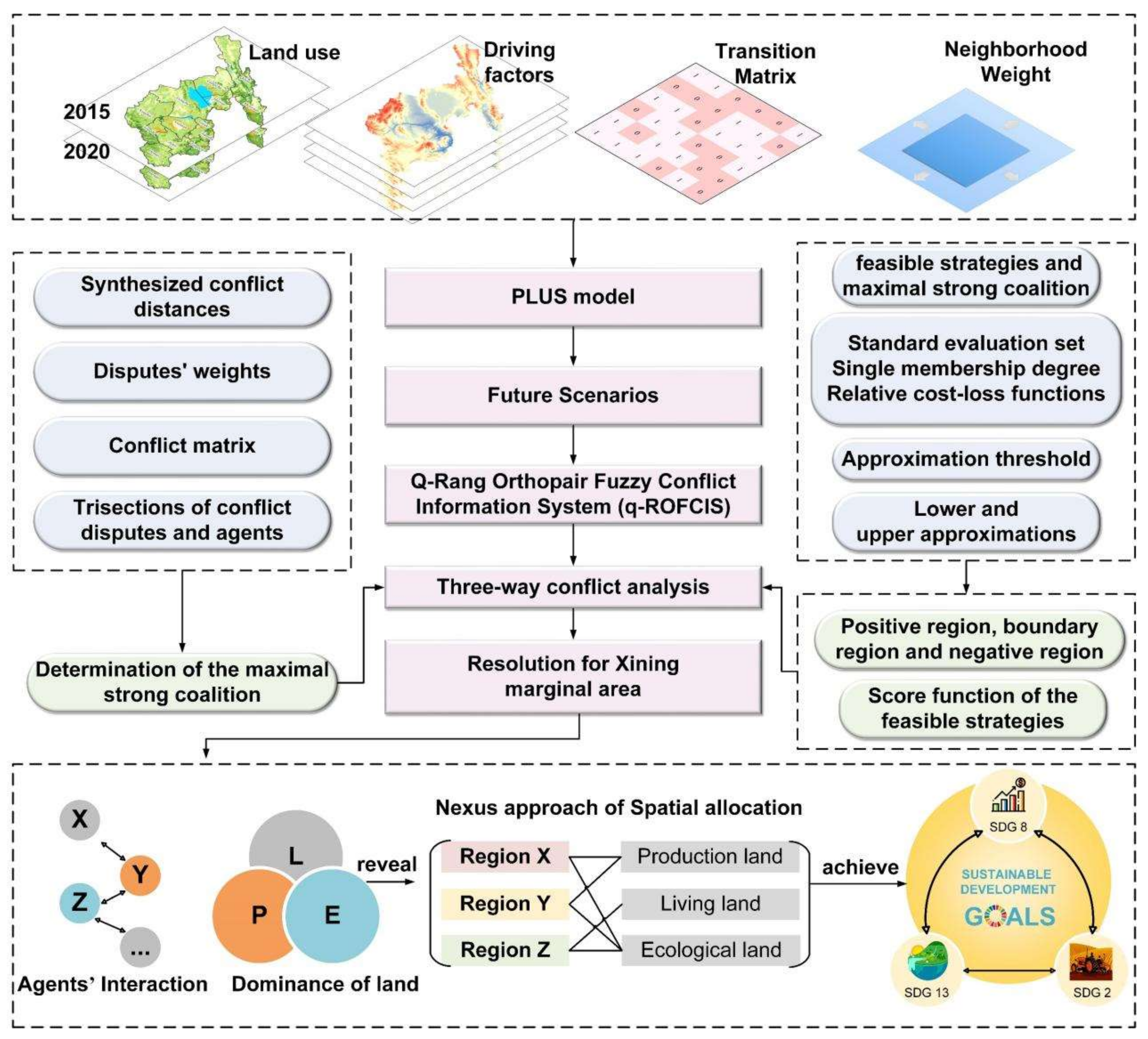

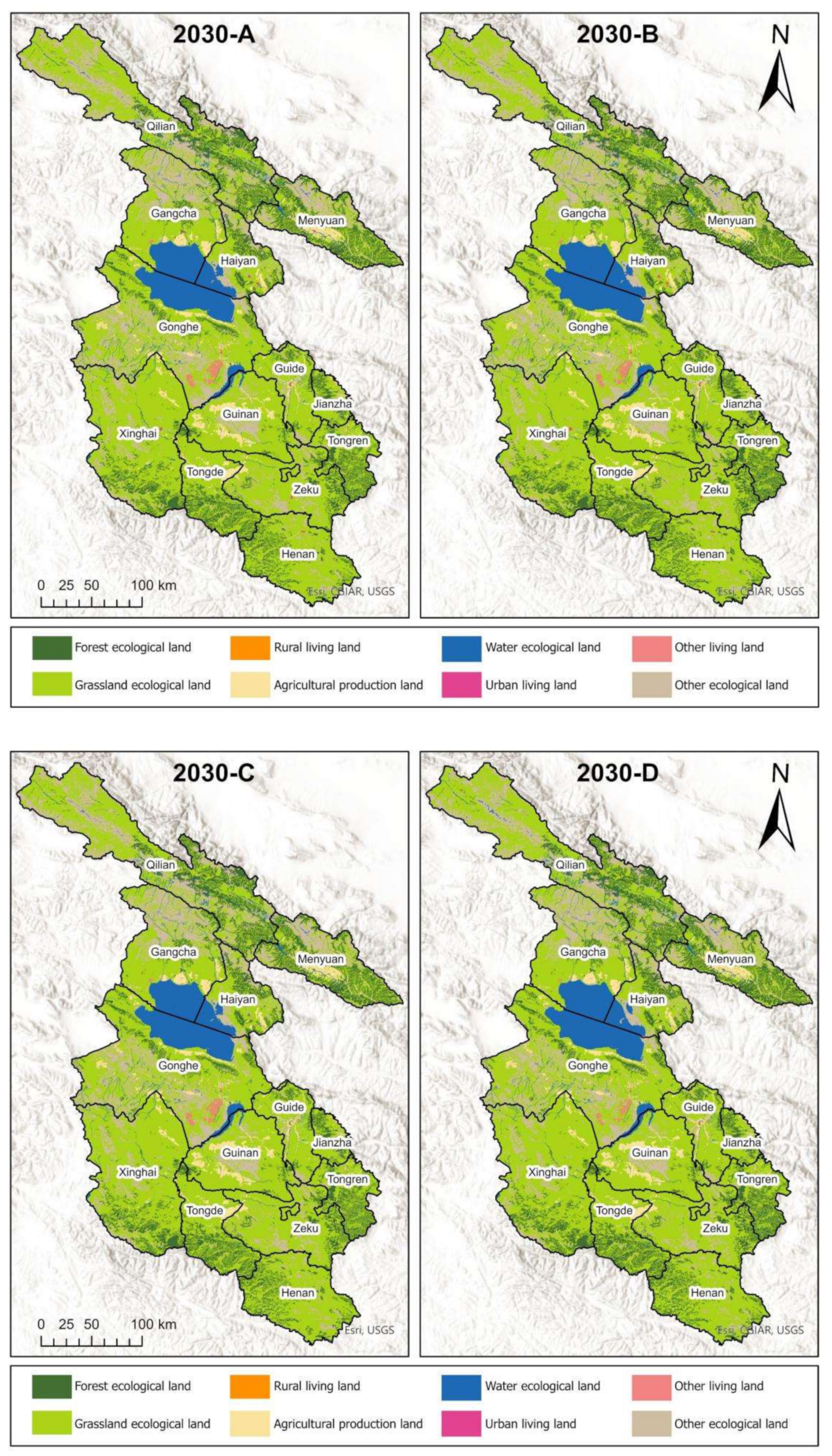

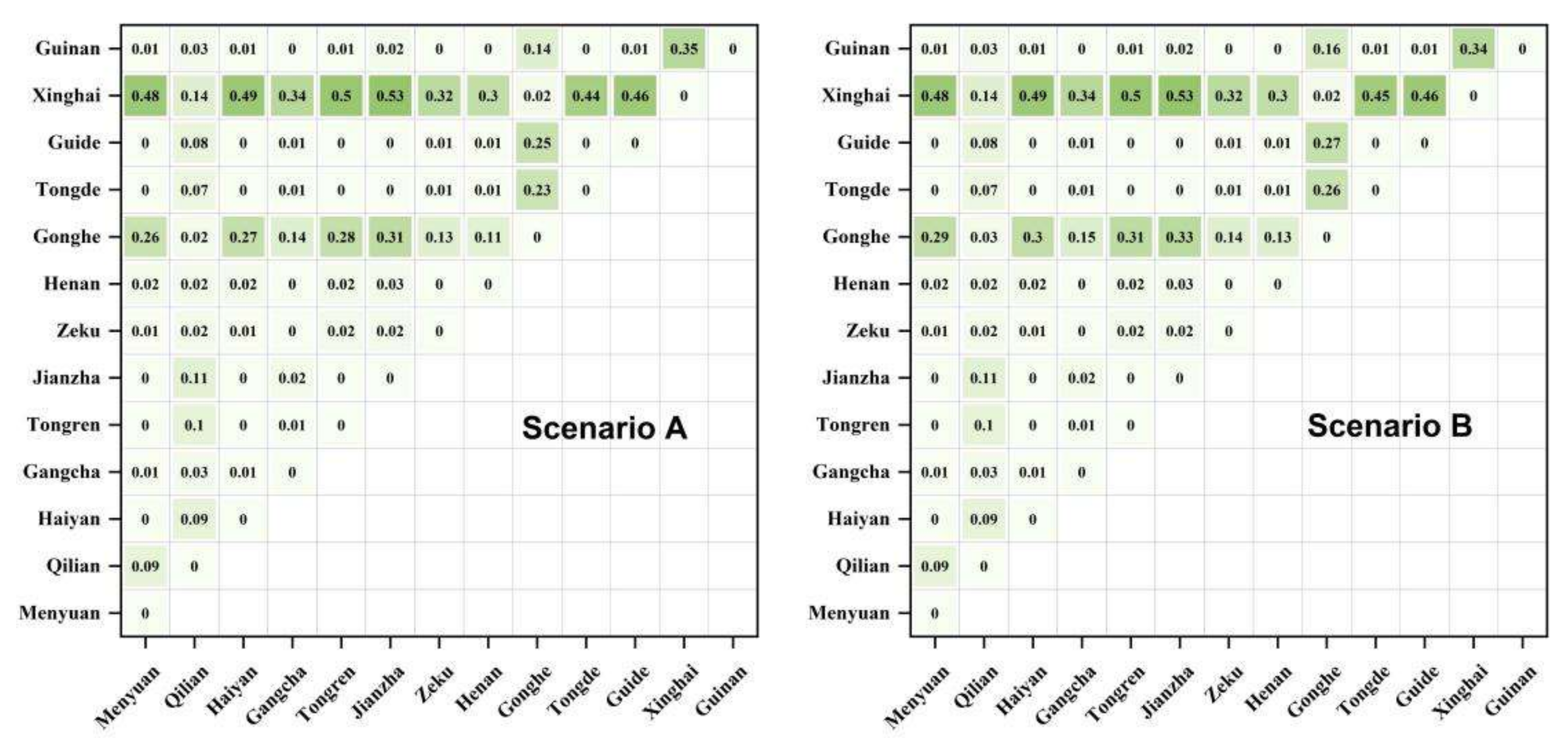
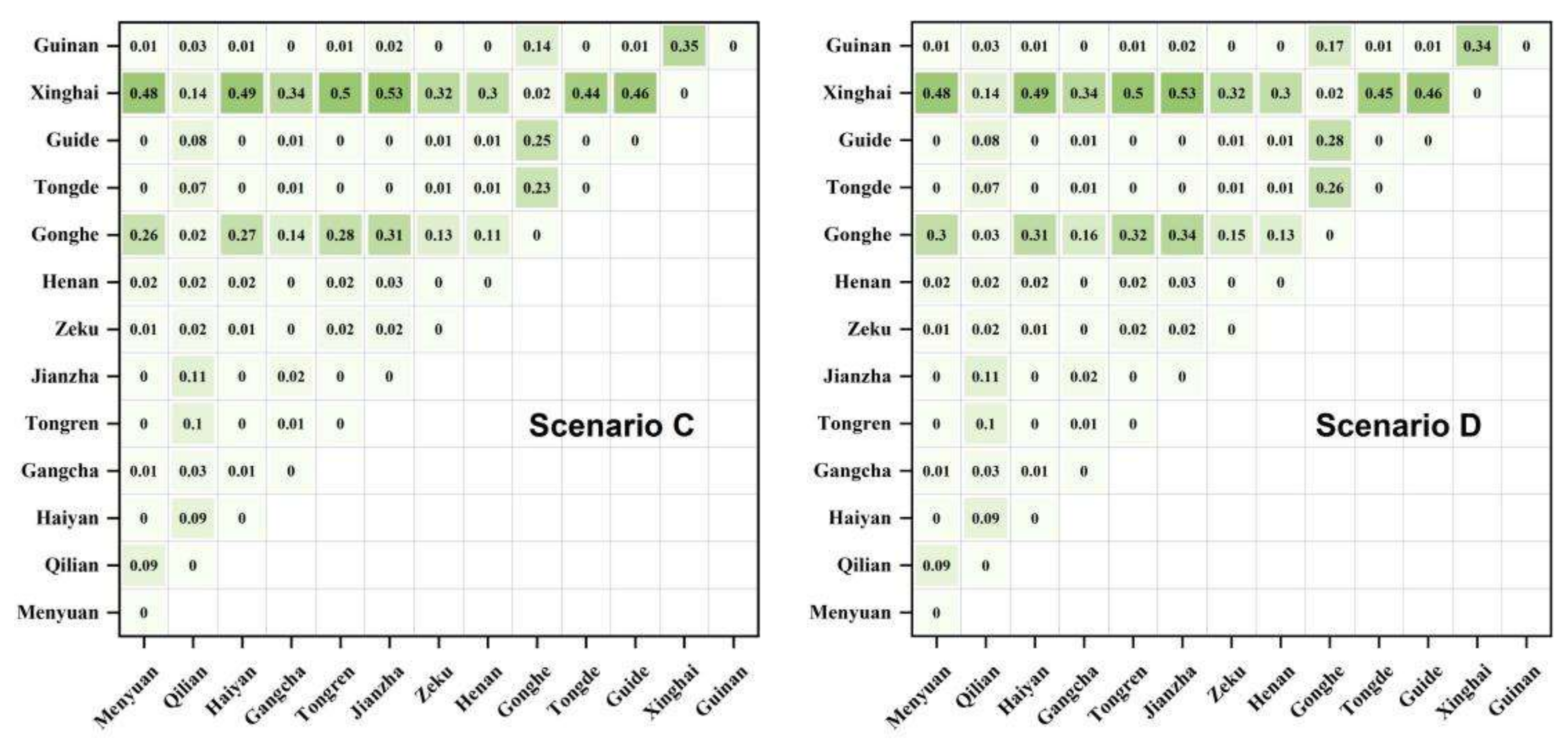

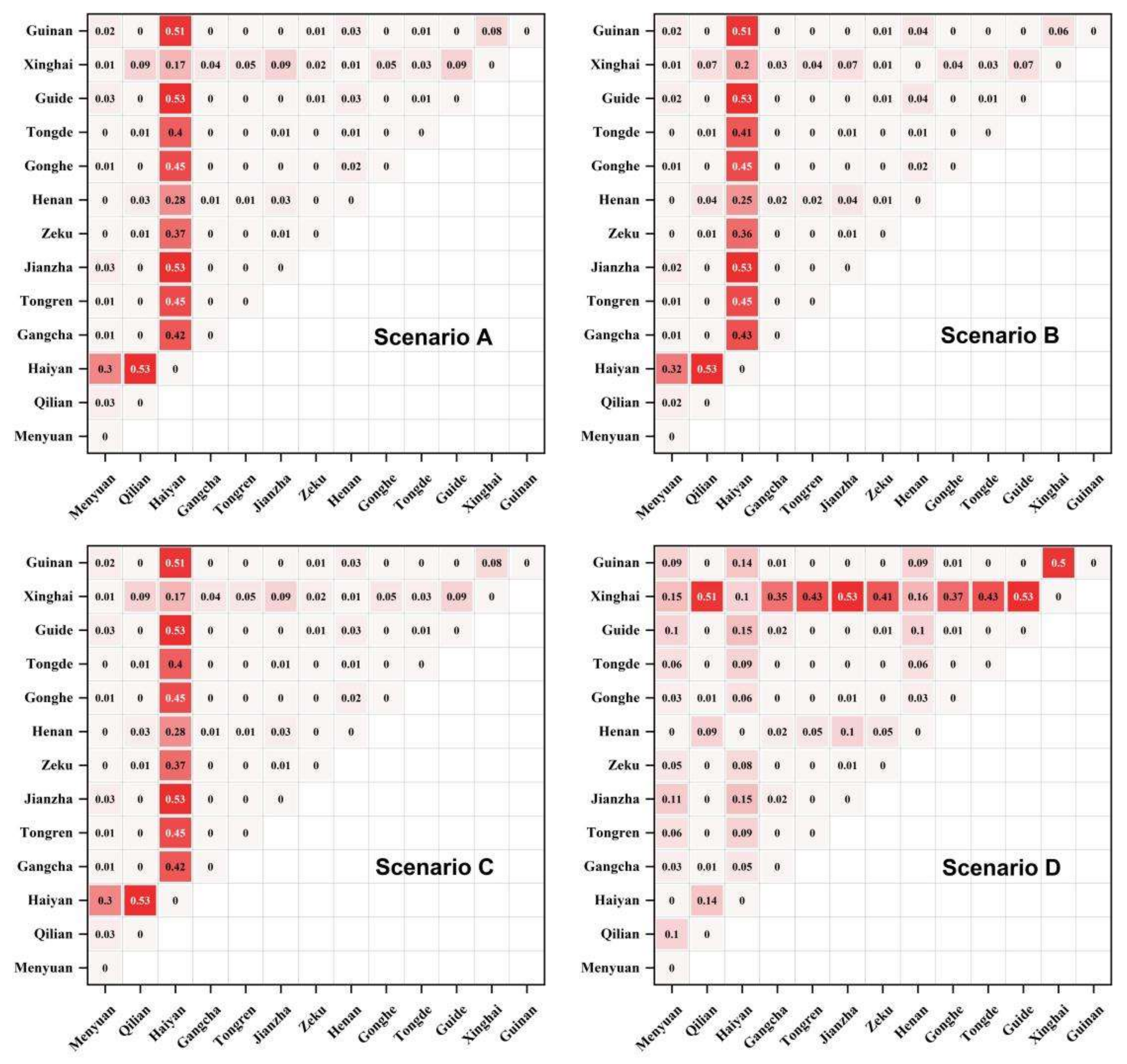
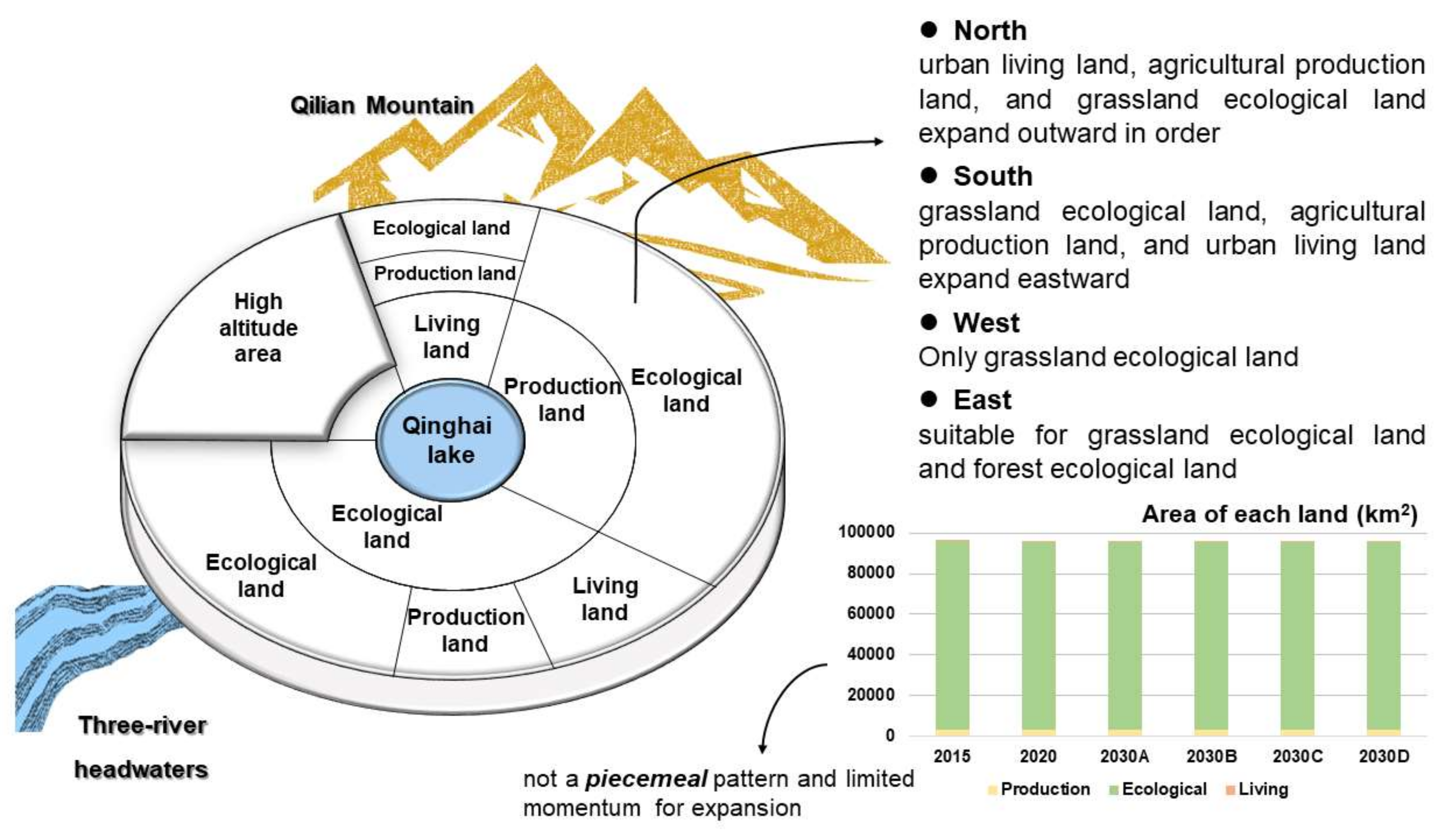
| Land | Sub-Land | Corresponding Land Use Type |
|---|---|---|
| Living land | Urban living land | Urban built-up land |
| Rural living land | Rural residential land | |
| Other living land | Other built-up land | |
| Production land | Agricultural production land | Dry land; Canal |
| Ecological land | Forest ecological land | Forest; shrub land; wood land; other forest |
| Grassland ecological land | High grassland; mid grassland; low grassland | |
| Water ecological land | Lake; reservoir-pond; snow; shallow | |
| Other living land | Sand; gobi; saline; swamp; barren land Rock; others |
| Data | Sub-Data | Year(s) | Resolution | Sources |
|---|---|---|---|---|
| Land use dataset | PLE land classification in Table 1 | 2015, 2020 | 30 m | https://www.resdc.cn/ accessed on 4 August 2022 |
| Socio-economic dataset | Population | 2020 | 1 km | https://www.resdc.cn/ accessed on 4 August 2022 |
| GDP | 2020 | 1 km | https://www.resdc.cn/ accessed on 4 August 2022 | |
| Primary roads | 2020 | Vector data | Open Street Map | |
| Seat of county government | 2015 | Vector data | http://www.dsac.cn/ accessed on 4 August 2022 | |
| Natural dataset | Elevation | 2015 | 1 km | https://www.resdc.cn/ accessed on 4 August 2022 |
| Slope | 2015 | 1 km | https://www.resdc.cn/ accessed on 4 August 2022 |
| Scenario A | Scenario B | Scenario C | Scenario D | |||||||||||||||||||||
|---|---|---|---|---|---|---|---|---|---|---|---|---|---|---|---|---|---|---|---|---|---|---|---|---|
| a | b | c | d | e | f | a | b | c | d | e | f | a | b | c | d | e | f | a | b | c | d | e | f | |
| a | 1 | 0 | 1 | 0 | 1 | 1 | 1 | 0 | 0 | 0 | 1 | 1 | 1 | 0 | 0 | 0 | 0 | 0 | 1 | 1 | 1 | 1 | 1 | 1 |
| b | 0 | 1 | 1 | 0 | 0 | 1 | 1 | 1 | 0 | 0 | 1 | 1 | 1 | 1 | 1 | 0 | 0 | 1 | 0 | 1 | 0 | 0 | 0 | 0 |
| c | 1 | 1 | 1 | 1 | 1 | 1 | 1 | 0 | 1 | 0 | 1 | 0 | 1 | 1 | 1 | 1 | 1 | 1 | 0 | 1 | 1 | 1 | 0 | 0 |
| d | 1 | 0 | 1 | 1 | 0 | 1 | 0 | 1 | 1 | 1 | 1 | 0 | 1 | 0 | 1 | 1 | 0 | 1 | 0 | 0 | 0 | 1 | 0 | 0 |
| e | 0 | 0 | 0 | 0 | 1 | 0 | 0 | 0 | 0 | 0 | 1 | 0 | 0 | 0 | 0 | 0 | 1 | 0 | 0 | 0 | 0 | 0 | 1 | 0 |
| f | 1 | 1 | 1 | 1 | 1 | 1 | 1 | 1 | 1 | 1 | 1 | 1 | 1 | 1 | 1 | 1 | 1 | 1 | 1 | 1 | 1 | 1 | 1 | 1 |
| Variety | Dry Land | Forest | Shrub Land | Wood Land | Other Forest | High Grassland |
|---|---|---|---|---|---|---|
| ΔTA | −193.77 | 35.46 | −1743.39 | −150.84 | 9.27 | 22,166.10 |
| Weight | 0.61 | 0.62 | 0.59 | 0.62 | 0.62 | 1 |
| Variety | Mid grassland | Low grassland | Canal | Lake | Reservoir-pond | Snow |
| ΔTA | −9190.26 | −35,812.26 | −1224 | 11,317.32 | 6207.93 | 1429.20 |
| Weight | 0.46 | 0 | 0.60 | 0.81 | 0.72 | 0.64 |
| Variety | Shallow | Urban built-up land | Rural residential land | Other built-up land | Sand | Gobi |
| ΔTA | −74.34 | 827.55 | 519.75 | 15,283.26 | −8804.97 | 18.09 |
| Weight | 0.62 | 0.63 | 0.63 | 0.88 | 0.47 | 0.62 |
| Variety | Saline | Swamp | Barren land | Rock | Others | |
| ΔTA | 101.97 | −1710.72 | 51.30 | 943.38 | −6.03 | |
| Weight | 0.62 | 0.59 | 0.62 | 0.63 | 0.62 |
| 2015 | 2020 | 2030A | 2030B | 2030C | 2030D | |
|---|---|---|---|---|---|---|
| Production | 3493.3536 | 3479.1759 | 3491.1495 | 3461.9418 | 3491.154 | 3501.3375 |
| Ecological | 92,416.092 | 92,263.964 | 92,125.742 | 92,156.133 | 92,125.723 | 92,233.14 |
| Living | 190.5417 | 356.8473 | 482.0958 | 481.9131 | 483.111 | 365.5098 |
| 2015 | 2020 | 2030-A | 2030-B | 2030-C | 2030-D | |||||
|---|---|---|---|---|---|---|---|---|---|---|
| Area | Area | Area | Rate | Area | Rate | Area | Rate | Area | Rate | |
| b1 | 3493.35 | 3479.18 | 3491.15 | 0.34 | 3461.94 | −0.50 | 3491.15 | 0.34 | 3501.34 | 0.64 |
| b2 | 128.65 | 133.85 | 143.80 | 7.44 | 143.80 | 7.44 | 143.80 | 7.44 | 134.19 | 0.26 |
| b3 | 34.32 | 42.49 | 49.22 | 15.84 | 51.48 | 21.15 | 49.28 | 15.97 | 41.97 | −1.23 |
| b4 | 11,520.62 | 11,502.13 | 11,471.60 | −0.27 | 11,935.99 | 3.77 | 11,471.60 | −0.27 | 11,957.16 | 3.96 |
| b5 | 6009.86 | 6198.66 | 6331.42 | 2.14 | 6265.49 | 1.08 | 6330.24 | 2.12 | 6303.99 | 1.70 |
| b6 | 59,935.19 | 59,706.83 | 59,504.39 | −0.34 | 59,313.26 | −0.66 | 59,504.63 | −0.34 | 59,458.24 | −0.42 |
| b7 | 14,950.42 | 14,856.35 | 14,819.34 | −0.25 | 14,641.39 | −1.45 | 14,819.26 | −0.25 | 14,513.76 | −2.31 |
| b8 | 27.68 | 180.51 | 289.08 | 60.14 | 286.64 | 58.79 | 290.04 | 60.67 | 189.35 | 4.90 |
| 2030-A | 2030-B | 2030-C | 2030-D | Conclusion | |||||
|---|---|---|---|---|---|---|---|---|---|
| Core | Edge | Core | Edge | Core | Edge | Core | Edge | ||
| b1 | 0.455 | 0.316 | −0.122 | −0.591 | 0.454 | 0.316 | 0.439 | 0.688 | all slightly increase except scenario B |
| b2 | 6.880 | 7.668 | 6.318 | 7.901 | 6.917 | 7.652 | 0.216 | 0.274 | increase overall except scenario D |
| b3 | 36.658 | 8.292 | 43.500 | 13.050 | 36.705 | 8.457 | 0.016 | −1.682 | more growth in the core area |
| b4 | −0.310 | −0.254 | 5.504 | 3.316 | −0.307 | −0.255 | 5.535 | 3.541 | varying according to the scenario |
| b5 | 2.745 | 1.352 | 1.808 | 0.123 | 2.715 | 1.348 | 1.272 | 2.258 | all slightly increase |
| b6 | −1.097 | −0.120 | −1.098 | −0.532 | −1.091 | −0.121 | −0.524 | −0.385 | all slightly decrease |
| b7 | −1.109 | 0.082 | −3.485 | −0.663 | −1.107 | 0.080 | −2.878 | −2.086 | more decrease in the core area |
| b8 | 63.892 | 44.063 | 60.806 | 50.150 | 63.937 | 46.679 | 5.809 | 0.992 | more growth in the core area |
| Scenario A | Scenario B | Scenario C | Scenario D | |
|---|---|---|---|---|
| Strong competitive set | {b6, b7} | {b6} | {b6, b7} | {b6, b7} |
| Weak competitive set | {b1, b5, b8} | {b1, b5, b7, b8} | {b1, b5, b8} | {b1, b2, b3, b5, b8} |
| Noncompetitive set | {b2, b3, b4} | {b2, b3, b4} | {b2, b3, b4} | {b4} |
| X | A | B | C | D |
|---|---|---|---|---|
| L1 | {L9, L12} | {L9, L12} | {L9, L12} | {L9, L12} |
| L2 | {L12} | {L12} | {L12} | {L12} |
| L3 | {L9, L12} | {L9, L12} | {L9, L12} | {L9, L12} |
| L4 | {L9, L12} | {L9, L12} | {L9, L12} | {L9, L12} |
| L5 | {L9, L12} | {L9, L12} | {L9, L12} | {L9, L12} |
| L6 | {L9, L12} | {L9, L12} | {L9, L12} | {L9, L12} |
| L7 | { L12} | {L9, L12} | {L12} | {L9, L12} |
| L8 | {L12} | {L12} | {L12} | {L12} |
| L9 | {L1, L3, L4, L5, L6, L10, L11, L13} | {L1, L3, L4, L5, L6, L7, L10, L11, L13} | {L1, L3, L4, L5, L6, L10, L11, L13} | {L1, L3, L4, L5, L6, L7, L10, L11, L13} |
| L10 | {L9, L12} | {L9, L12} | {L9, L12} | {L9, L12} |
| L11 | {L9, L12} | {L9, L12} | {L9, L12} | {L9, L12} |
| L12 | {L1, L2, L3, L4, L5, L6, L7, L8, L10, L11, L13} | {L1, L2, L3, L4, L5, L6, L7, L8, L10, L11, L13} | {L1, L2, L3, L4, L5, L6, L7, L8, L10, L11, L13} | {L1, L2, L3, L4, L5, L6, L7, L8, L10, L11, L13} |
| L13 | {L9, L12} | {L9, L12} | {L9, L12} | {L9, L12} |
| X | A | B | C | D |
|---|---|---|---|---|
| L1 | {L2, L5, L6, L8} | {L2, L5, L6, L8} | {L2, L5, L6, L8} | {L2, L5, L6, L8} |
| L2 | {L1, L13} | {L1, L13} | {L1, L13} | {L1, L13} |
| L3 | {L13} | {L13} | {L13} | {L13} |
| L4 | {L13} | {L13} | {L13} | {L13} |
| L5 | {L1, L13} | {L1, L13} | {L1, L13} | {L1, L13} |
| L6 | {L1, L13} | {L1, L13} | {L1, L13} | {L1, L13} |
| L7 | {L13} | {L13} | {L13} | {L13} |
| L8 | {L1, L13} | {L1, L13} | {L1, L13} | {L1, L13} |
| L9 | {L13} | {L13} | {L13} | {L13} |
| L10 | {L13} | {L13} | {L13} | {L13} |
| L11 | {L13} | {L13} | {L13} | {L13} |
| L12 | {L13} | {L13} | {L13} | {L13} |
| L13 | {L2, L3, L4, L5, L6, L7, L8, L9, L10, L11, L12} | {L2, L3, L4, L5, L6, L7, L8, L9, L10, L11, L12} | {L2, L3, L4, L5, L6, L7, L8, L9, L10, L11, L12} | {L2, L3, L4, L5, L6, L7, L8, L9, L10, L11, L12} |
| X | A | B | C | D |
|---|---|---|---|---|
| L1 | {L3} | {L3} | {L3} | {L12} |
| L2 | {L3} | {L3} | {L3} | {L3, L12} |
| L3 | {L1, L2, L4, L5, L6, L7, L8, L9, L10, L11, L12, L13} | {L1, L2, L4, L5, L6, L7, L8, L9, L10, L11, L12, L13} | {L1, L2, L4, L5, L6, L7, L8, L9, L10, L11, L12, L13} | {L2, L6, L11, L13} |
| L4 | {L3} | {L3} | {L3} | {L12} |
| L5 | {L3} | {L3} | {L3} | {L12} |
| L6 | {L3} | {L3} | {L3} | {L3, L12} |
| L7 | {L3} | {L3} | {L3} | {L12} |
| L8 | {L3} | {L3} | {L3} | {L12} |
| L9 | {L3} | {L3} | {L3} | {L12} |
| L10 | {L3} | {L3} | {L3} | {L12} |
| L11 | {L3} | {L3} | {L3} | {L3, L12} |
| L12 | {L3} | {L3} | {L3} | {L1, L2, L4, L5, L6, L7, L8, L9, L10, L11, L12, L13} |
| L13 | {L3} | {L3} | {L3} | {L3, L12} |
Disclaimer/Publisher’s Note: The statements, opinions and data contained in all publications are solely those of the individual author(s) and contributor(s) and not of MDPI and/or the editor(s). MDPI and/or the editor(s) disclaim responsibility for any injury to people or property resulting from any ideas, methods, instructions or products referred to in the content. |
© 2024 by the authors. Licensee MDPI, Basel, Switzerland. This article is an open access article distributed under the terms and conditions of the Creative Commons Attribution (CC BY) license (https://creativecommons.org/licenses/by/4.0/).
Share and Cite
Jiang, Z.; Luo, Y.; Wen, Q.; Shi, M.; Ayyamperumal, R.; Wang, M. Achieving Sustainable Land Use Allocation in High-Altitude Area by 2030: Insights from Circle Structure and Scenario Predictions for Production–Living–Ecological Land in Xining Marginal Area, China. Land 2024, 13, 1241. https://doi.org/10.3390/land13081241
Jiang Z, Luo Y, Wen Q, Shi M, Ayyamperumal R, Wang M. Achieving Sustainable Land Use Allocation in High-Altitude Area by 2030: Insights from Circle Structure and Scenario Predictions for Production–Living–Ecological Land in Xining Marginal Area, China. Land. 2024; 13(8):1241. https://doi.org/10.3390/land13081241
Chicago/Turabian StyleJiang, Zizhen, Yuxuan Luo, Qi Wen, Mingjie Shi, Ramamoorthy Ayyamperumal, and Meimei Wang. 2024. "Achieving Sustainable Land Use Allocation in High-Altitude Area by 2030: Insights from Circle Structure and Scenario Predictions for Production–Living–Ecological Land in Xining Marginal Area, China" Land 13, no. 8: 1241. https://doi.org/10.3390/land13081241







